Facts About Sunscreen and Sun Protection

Skin cancer is the most common form of cancer in the United States, according to the Centers for Disease Control (CDC), but it is also the most preventable because sun exposure is a major factor in its growth. The best line of defense against skin cancer is sunscreen and skin protection.
What is sunscreen?
Sunscreen is basically a barrier that protects the skin from absorbing ultraviolet (UV) rays. There are two kinds of UV rays that can affect the skin. UVA rays tend to age the skin. UVB rays typically cause sunburn.
Sunscreen is considered an over-the-counter drug and is regulated by the by the U.S. Food and Drug Administration (FDA). Due to FDA regulations, a sunscreen can only be called "broad spectrum" if it protects against both types of UV rays.
In addition to broad spectrum information, the label will also have a number called sun protection factor (SPF). The SPF is a rating of how well the sunscreen blocks the sun. For example, a sunscreen with a 30 SPF rating blocks 97 percent of the sun's UVB rays, according to the American Academy of Dermatology. The higher the number, the better it works at blocking UVB rays.
It is important to note, however, that no sunscreen blocks 100 percent of UV rays. Also, no matter how high the number, all sunscreens protect for the same amount of time. An 80 SPF sunscreen, for example, doesn't let someone stay outside longer than a 15 SPF sunscreen. The 80 SPF just blocks more rays while the person is outside. All sunscreen needs to be reapplied at least every two hours or immediately after swimming or sweating.
Sunscreen should be stored in a cool, dry place. With proper storage, a bottle can last five to 10 years. [How Long Does Sunscreen Last Before It Expires?]
What type of sunscreen is best?
There are hundreds of brands of sunscreen on the market, but they all aren't created equal. Some have better protection than others.
"This summer, opt for sunscreens that offer full protection," said Dr. Peter Capizzi, a cosmetic surgeon at Capizzi MD Cosmetic Surgery in Charlotte, North Carolina. "While traditional sunscreens protect against UVA and UVB rays, choose a sunscreen that also protects against HEV (high-energy visible) light, which has been shown to induce skin cancer, premature aging and hyperpigmentation."
Also choose a sunscreen that has a high SPF rating. "Use a sunscreen of at least 30 SPF, even on overcast days," said Dr. Dheeraj Taranath, a regional medical director with MedExpress in Reading, Pennsylvania.
Sunscreen that is water resistant can also be helpful, especially when swimming or sweating.
How much sunscreen is needed?
Most people don't use enough sunscreen to fully protect their skin, according to the American Academy of Dermatology. In fact, most people only use 25 to 50 percent of the recommended amount of sunscreen.
A liberal amount is needed to fully cover the skin. "A shot glass (1 ounce) of sunscreen is an adequate amount to be used when most of your skin is exposed while wearing a swimsuit and should be reapplied every two hours," Dr. Delphine J. Lee, dermatologist at Providence Saint John's Health Center in Santa Monica, California, told Live Science.
Many people wait to put on sunscreen when already outside. This is a no-no. Sunscreen should be applied 20 minutes before going outside to allow it to bond with the skin.
Also, applying sunscreen to the lips shouldn't be forgotten. Lip balms that contain sunscreen is the best way to protect the lip area. It should be reapplied regularly, especially if the person has a habit of licking their lips.
What other types of protection are there?
Other than sunscreen, there are many ways to protect the body from the sun's rays. Swimwear that is specifically designed to block the UV rays can be helpful. Seeking shade or wearing long sleeves, pants and a wide-brimmed hat can also be good ways to prevent sun damage to the skin. UV blocking tint on car and home windows can also block out UV rays during day-to-day life.
Eyes can also get sunburned and be damaged by the sun's rays, according to the Mayo Clinic, so it is important to protect them, as well. Sunglasses or eyeglasses that filter out 100 percent of the UV ray spectrum is best.
"The sun can cause serious damage to your eyes and its effects can begin in as little as 15 minutes," said Dr. Janelle Routhier, senior director of customer development at Essilor, a manufacturer of optical lenses in the United States. "UV damage is cumulative and often irreversible. There is actually no amount of UV radiation that is healthy for the eyes and repeated exposure can increase your chances of developing eyelid skin cancer, cataracts, or experiencing temporary blindness."
Even while wearing sunglasses, though, light can still enter the eyes from the side and from the back by reflecting off the back of the sunglass lens and into the eyes. Choose polarized sunglasses that include an antireflective coating on the backside lenses to prevent this reflection into the eyes, recommends Routhier.
Additional resources
Sign up for the Live Science daily newsletter now
Get the world’s most fascinating discoveries delivered straight to your inbox.











